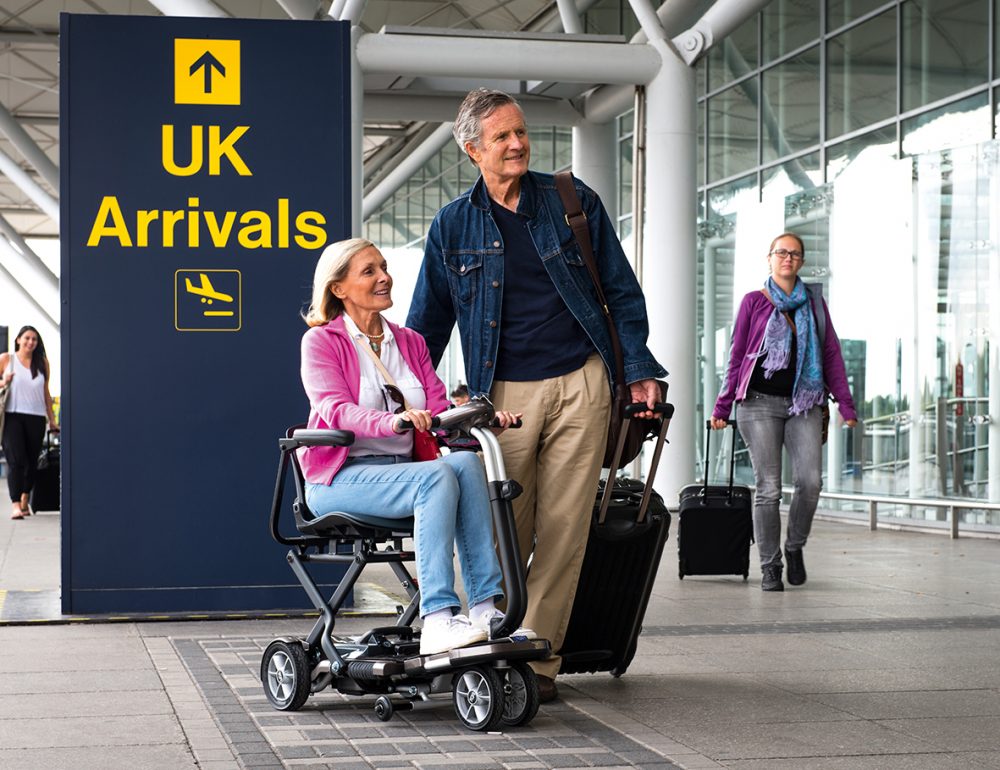
Another option to consider for longer distance domestic journeys is air travel. There are often low-cost options available.
Booking
If you need assistance to help you get through the airport or on and off the plane, you should ask for it when you book your flights. All the airline websites include the option to ask for assistance and to book it either online or through a freephone telephone call.
If you are not sure how the big the airports are that you will be using, you can usually find information on the airport website. If you are not sure it is better to ask for assistance.
If you are travelling with an assistance dog, you must inform the airline in advance. They may ask for evidence that your dog has been formally trained as an assistance dog.
There is more information on this and other aspects of travelling with an assistance dog at https://www.guidedogs.org.uk/resources/guide-dog-owners/assistance-dog-travel-guide/travel-by-air
At the Airport
The assistance you need is available from anywhere that you arrive at the airport such as the long-term car park, the train or bus station or taxi rank. You should find a Help Point clearly marked which enables you to let the airport know that you have arrived. They will then send the assistance to meet you.
If you are a full-time wheelchair user, someone will assist you through the airport, including checking in your bags, going through security, getting to the toilet etc.
If you are not a wheelchair user but are unable to manage long distances, the assistance may be on a buggy with other passengers. Your baggage will be taken care of and you will be helped through the whole process.
Getting on board
If your flight is at a jetway attached to the airport building, boarding is on the level and you can stay in your own wheelchair to the door of the aircraft. You will then be lifted or assisted into your seat and your chair will be stowed in the aircraft hold. It should be brought back to you at the door when your flight lands.
Sometimes at smaller airports, your plane may not be near the building and you will be lifted on board using an Ambulift which will bring you to the aircraft door. If the plane is very small (for example, some of the island-hopping services, it may not be possible to use an ambulift and you may need to be carried on board in a special carry chair.
Toilets
All larger aircraft now have accessible toilets and if you are unable to walk, you will be assisted to/from the toilet in an onboard wheelchair. But be aware that cabin crew cannot help you to use the toilet. Contact the airline if you are unsure whether there will be an onboard toilet.
Mobility equipment and medication
You can take two pieces of mobility equipment (two wheelchairs or a scooter and a walker for example) free of charge. If your wheelchair is powered you will have to provide information in advance on its weight, battery type etc. The airline website will help you through this process.
You can also take as much medical equipment and medication as you need. You should always take medication with you in the cabin just in case there are delays or baggage is lost. You should bring a doctor’s certificate with you to confirm what the medication is so that it can be cleared by security.
Assistance Dogs
There is no problem travelling with an assistance dogs on routes within the UK but you need to let the airline know in advance so they can allocate a seat with suitable leg room for you and the dog.
You should also note that some airlines only accept assistance dogs, not pets so you must have your dog’s official ID with you to prove that it has been formally trained as an assistance dog.
There may be a Transport Hub near you which could help and offer advice and guidance.
